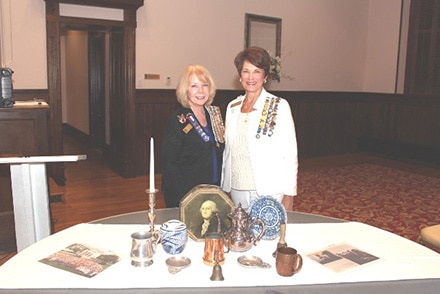
These rooms consist of various room types (parlor, dining room, one-room house, bedroom, etc.), each furnished in the style of a specific time period during colonial and early America. Information was presented about the various objects in the rooms, their history and function.
The Georgia Room in the Museum is a tavern, based on Peter Tondee’s Tavern in Savannah, Georgia. The “Sons of Liberty” frequently met at this tavern, and it was the place where the first reading of the Declaration of Independence occurred in Georgia on August 10, 1776. A 1775 estate inventory of the tavern, following Peter Tondee’s death, provided the historical basis for objects in this Period Room. Mrs. McGill displayed her collection of antique and replica objects that depicted items in Tondee’s Tavern.
Mrs. McGill and Ms. Story are currently in training under the direction of the DAR National Society Museum Curator General, National Museum Co-Chair, and Museum Staff in Washington D.C. to become DAR Museum Correspondent Docents.
The DAR Museum is located at Memorial Continental Hall in Washington D.C. which serves as the national headquarters of the NSDAR. The Museum has been collecting objects since 1890. Today the collection includes more than 30,000 examples of decorative and fine arts. Furniture, silver, paintings, ceramics, and textiles such as quilts and costumes that are exhibited in 31 period rooms and two galleries.
For more information on the DAR Museum, visit www.dar.org or email historian@dar.org

